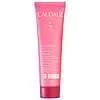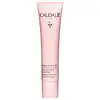What's inside
What's inside
 Key Ingredients
Key Ingredients

 Benefits
Benefits

 Concerns
Concerns

 Ingredients Side-by-side
Ingredients Side-by-side

Water
Skin ConditioningVitis Vinifera Fruit Water
Skin ConditioningDicaprylyl Ether
EmollientGlycerin
HumectantButyrospermum Parkii Butter Extract
Skin ConditioningHexyldecanol
EmollientHexyldecyl Laurate
EmollientPalmitoyl Grape Seed Extract
Skin ConditioningBehenyl Alcohol
EmollientGlyceryl Stearate
EmollientAcrylates/C10-30 Alkyl Acrylate Crosspolymer
Emulsion StabilisingErythritol
HumectantLecithin
EmollientMannitol
HumectantTocopherol
AntioxidantCaprylyl Glycol
EmollientHelianthus Annuus Seed Oil
EmollientXanthan Gum
EmulsifyingSodium Benzoate
MaskingVitis Vinifera Juice
AntioxidantGlycine Soja Sterols
EmollientButylene Glycol
HumectantChamomilla Recutita Flower Extract
MaskingSodium Hydroxide
BufferingCitric Acid
BufferingSodium Carboxymethyl Beta-Glucan
CleansingSodium Citrate
BufferingSodium Phytate
Potassium Sorbate
PreservativeBiosaccharide Gum-1
HumectantSodium Hyaluronate
HumectantSodium Levulinate
Skin ConditioningGlyceryl Caprylate
EmollientHomarine Hcl
Skin ConditioningSodium Anisate
AntimicrobialAlcohol
AntimicrobialAcetyl Tetrapeptide-15
Skin ConditioningParfum
MaskingWater, Vitis Vinifera Fruit Water, Dicaprylyl Ether, Glycerin, Butyrospermum Parkii Butter Extract, Hexyldecanol, Hexyldecyl Laurate, Palmitoyl Grape Seed Extract, Behenyl Alcohol, Glyceryl Stearate, Acrylates/C10-30 Alkyl Acrylate Crosspolymer, Erythritol, Lecithin, Mannitol, Tocopherol, Caprylyl Glycol, Helianthus Annuus Seed Oil, Xanthan Gum, Sodium Benzoate, Vitis Vinifera Juice, Glycine Soja Sterols, Butylene Glycol, Chamomilla Recutita Flower Extract, Sodium Hydroxide, Citric Acid, Sodium Carboxymethyl Beta-Glucan, Sodium Citrate, Sodium Phytate, Potassium Sorbate, Biosaccharide Gum-1, Sodium Hyaluronate, Sodium Levulinate, Glyceryl Caprylate, Homarine Hcl, Sodium Anisate, Alcohol, Acetyl Tetrapeptide-15, Parfum
Water
Skin ConditioningCaprylic/Capric Triglyceride
MaskingIsostearyl Isostearate
EmollientCoco-Caprylate/Caprate
EmollientHeptyl Undecylenate
EmollientButylene Glycol
HumectantSilica
AbrasiveGlycerin
HumectantSqualane
EmollientCI 77891
Cosmetic ColorantGlyceryl Stearate Citrate
EmollientPotassium Cetyl Phosphate
EmulsifyingPalmitoyl Grapevine Shoot Extract
AntioxidantMica
Cosmetic ColorantPolyglyceryl-3 Stearate
EmulsifyingTocopheryl Acetate
AntioxidantBenzyl Alcohol
PerfumingHydrogenated Lecithin
EmulsifyingCaprylyl Glycol
EmollientXanthan Gum
EmulsifyingHydrolyzed Hyaluronic Acid
HumectantPolyacrylate Crosspolymer-6
Emulsion StabilisingAdenosine
Skin ConditioningDehydroacetic Acid
PreservativeAcetyl Dipeptide-1 Cetyl Ester
Skin ConditioningHyaluronic Acid
HumectantSodium Phytate
Khaya Senegalensis Bark Extract
Skin ProtectingMaltodextrin
AbsorbentTin Oxide
AbrasivePaeonia Lactiflora Root Extract
Skin ConditioningTocopherol
AntioxidantSodium Hydroxide
BufferingParfum
MaskingLinalool
PerfumingLimonene
PerfumingCoumarin
PerfumingWater, Caprylic/Capric Triglyceride, Isostearyl Isostearate, Coco-Caprylate/Caprate, Heptyl Undecylenate, Butylene Glycol, Silica, Glycerin, Squalane, CI 77891, Glyceryl Stearate Citrate, Potassium Cetyl Phosphate, Palmitoyl Grapevine Shoot Extract, Mica, Polyglyceryl-3 Stearate, Tocopheryl Acetate, Benzyl Alcohol, Hydrogenated Lecithin, Caprylyl Glycol, Xanthan Gum, Hydrolyzed Hyaluronic Acid, Polyacrylate Crosspolymer-6, Adenosine, Dehydroacetic Acid, Acetyl Dipeptide-1 Cetyl Ester, Hyaluronic Acid, Sodium Phytate, Khaya Senegalensis Bark Extract, Maltodextrin, Tin Oxide, Paeonia Lactiflora Root Extract, Tocopherol, Sodium Hydroxide, Parfum, Linalool, Limonene, Coumarin
 Reviews
Reviews

Ingredients Explained
These ingredients are found in both products.
Ingredients higher up in an ingredient list are typically present in a larger amount.
Butylene Glycol (or BG) is used within cosmetic products for a few different reasons:
Overall, Butylene Glycol is a safe and well-rounded ingredient that works well with other ingredients.
Though this ingredient works well with most skin types, some people with sensitive skin may experience a reaction such as allergic rashes, closed comedones, or itchiness.
Learn more about Butylene GlycolCaprylyl Glycol is a humectant and emollient, meaning it attracts and preserves moisture.
It is a common ingredient in many products, especially those designed to hydrate skin. The primary benefits are retaining moisture, skin softening, and promoting a healthy skin barrier.
Though Caprylyl Glycol is an alcohol derived from fatty acids, it is not the kind that can dry out skin.
This ingredient is also used as a preservative to extend the life of products. It has slight antimicrobial properties.
Learn more about Caprylyl GlycolGlycerin is already naturally found in your skin. It helps moisturize and protect your skin.
A study from 2016 found glycerin to be more effective as a humectant than AHAs and hyaluronic acid.
As a humectant, it helps the skin stay hydrated by pulling moisture to your skin. The low molecular weight of glycerin allows it to pull moisture into the deeper layers of your skin.
Hydrated skin improves your skin barrier; Your skin barrier helps protect against irritants and bacteria.
Glycerin has also been found to have antimicrobial and antiviral properties. Due to these properties, glycerin is often used in wound and burn treatments.
In cosmetics, glycerin is usually derived from plants such as soybean or palm. However, it can also be sourced from animals, such as tallow or animal fat.
This ingredient is organic, colorless, odorless, and non-toxic.
Glycerin is the name for this ingredient in American English. British English uses Glycerol/Glycerine.
Learn more about GlycerinParfum is a catch-all term for an ingredient or more that is used to give a scent to products.
Also called "fragrance", this ingredient can be a blend of hundreds of chemicals or plant oils. This means every product with "fragrance" or "parfum" in the ingredients list is a different mixture.
For instance, Habanolide is a proprietary trade name for a specific aroma chemical. When used as a fragrance ingredient in cosmetics, most aroma chemicals fall under the broad labeling category of “FRAGRANCE” or “PARFUM” according to EU and US regulations.
The term 'parfum' or 'fragrance' is not regulated in many countries. In many cases, it is up to the brand to define this term.
For instance, many brands choose to label themselves as "fragrance-free" because they are not using synthetic fragrances. However, their products may still contain ingredients such as essential oils that are considered a fragrance by INCI standards.
One example is Calendula flower extract. Calendula is an essential oil that still imparts a scent or 'fragrance'.
Depending on the blend, the ingredients in the mixture can cause allergies and sensitivities on the skin. Some ingredients that are known EU allergens include linalool and citronellol.
Parfum can also be used to mask or cover an unpleasant scent.
The bottom line is: not all fragrances/parfum/ingredients are created equally. If you are worried about fragrances, we recommend taking a closer look at an ingredient. And of course, we always recommend speaking with a professional.
Learn more about ParfumSodium Hydroxide is also known as lye or caustic soda. It is used to adjust the pH of products; many ingredients require a specific pH to be effective.
In small amounts, sodium hydroxide is considered safe to use. However, large amounts may cause chemical burns due to its high alkaline.
Your skin has a natural pH and acid mantle. This acid mantle helps prevent harmful bacteria from breaking through. The acid mantle also helps keep your skin hydrated.
"Alkaline" refers to a high pH level. A low pH level would be considered acidic.
Learn more about Sodium HydroxideSodium Phytate is the synthetic salt form of phytic acid. Phytic acid is an antioxidant and can be found in plant seeds.
Sodium Phytate is a chelating agent. Chelating agents help prevent metals from binding to water. This helps stabilize the ingredients and the product.
Tocopherol (also known as Vitamin E) is a common antioxidant used to help protect the skin from free-radicals and strengthen the skin barrier. It's also fat soluble - this means our skin is great at absorbing it.
Vitamin E also helps keep your natural skin lipids healthy. Your lipid skin barrier naturally consists of lipids, ceramides, and fatty acids. Vitamin E offers extra protection for your skin’s lipid barrier, keeping your skin healthy and nourished.
Another benefit is a bit of UV protection. Vitamin E helps reduce the damage caused by UVB rays. (It should not replace your sunscreen). Combining it with Vitamin C can decrease sunburned cells and hyperpigmentation after UV exposure.
You might have noticed Vitamin E + C often paired together. This is because it is great at stabilizing Vitamin C. Using the two together helps increase the effectiveness of both ingredients.
There are often claims that Vitamin E can reduce/prevent scarring, but these claims haven't been confirmed by scientific research.
Learn more about TocopherolWater. It's the most common cosmetic ingredient of all. You'll usually see it at the top of ingredient lists, meaning that it makes up the largest part of the product.
So why is it so popular? Water most often acts as a solvent - this means that it helps dissolve other ingredients into the formulation.
You'll also recognize water as that liquid we all need to stay alive. If you see this, drink a glass of water. Stay hydrated!
Learn more about WaterXanthan gum is used as a stabilizer and thickener within cosmetic products. It helps give products a sticky, thick feeling - preventing them from being too runny.
On the technical side of things, xanthan gum is a polysaccharide - a combination consisting of multiple sugar molecules bonded together.
Xanthan gum is a pretty common and great ingredient. It is a natural, non-toxic, non-irritating ingredient that is also commonly used in food products.
Learn more about Xanthan Gum